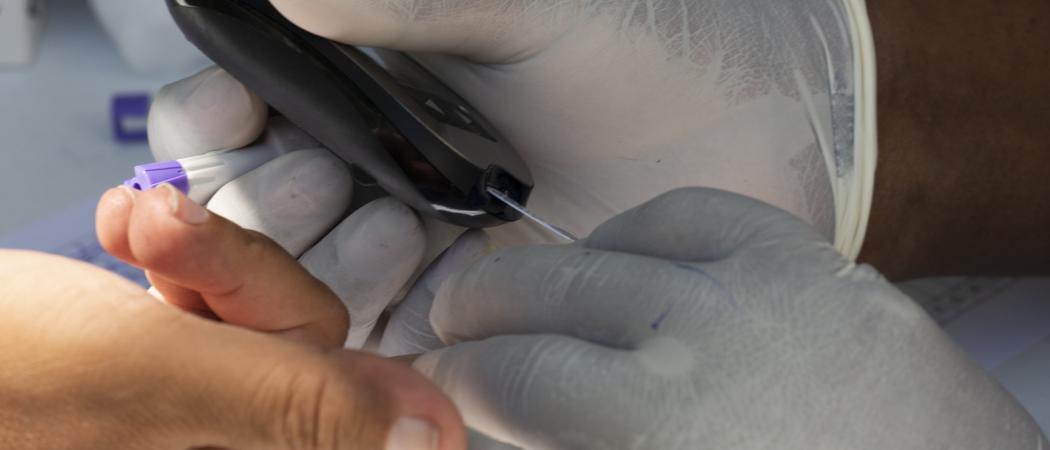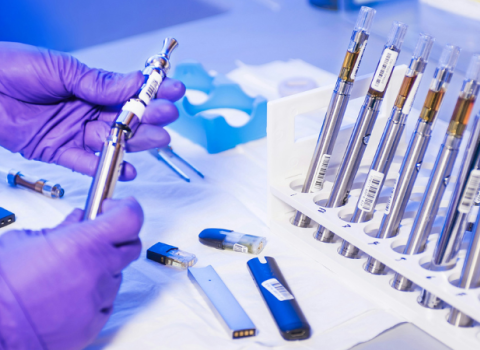
The prototype that ETH Pioneer Fellow Alexander Tanno is holding between his thumb and forefinger doesn’t look particularly impressive. Measuring two centimetres by two centimetres, the clear plastic block is equipped with three electrodes and encloses a sample on a paper strip. But this inconspicuous device can do something exceptional: it turns a qualitative blood test into a quantitative one. This makes the test itself much more sensitive. Tanno’s invention makes it possible to have sensitive blood tests that patients can perform wherever it suits them.
“Today, more than two-thirds of all medical diagnoses require a blood test,” Tanno says. Until now, these tests have been done using relatively bulky devices housed in hospitals or doctors’ surgeries. The blood analysis they provide allows medical professionals to ascertain, for example, whether chest pain indicates a heart attack. Since we know that when someone has a heart attack their blood will show increased levels of a certain protein, measuring its concentration in the blood can help diagnose or rule out a heart attack. In the same way, measuring the amount of certain molecules in the blood helps to diagnose a whole range of other conditions.
A step further
Tanno’s goal now is to develop a range of blood test kits that offer similar diagnostic benefits while also being small, portable and easy to use, so patients can carry them with them and perform tests anywhere. The technology is based on the lateral flow test, which, as in a pregnancy test, produces visible lines to indicate a particular result. Although such tests are fast and inexpensive, they provide only qualitative measurements. In other words, the result is either positive or negative; gradations are not detectable. The way these tests work is to apply the blood sample to a test strip, where the desired molecule in the blood is caught by certain antibodies,
and together they bind to gold nanoparticles. It is the gold particles that make the molecule visible to the eye – but only when enough gold particles come together. If the concentration of the blood components being tested is too low, and therefore the quantity of bonded gold particles too small to be visible to the eye, the test is useless.
Tanno solved this particular problem by finding a way of using a chemical reaction to dissolve the bonded gold particles. Once dissolved, the particles can be measured more precisely in a further step. The reaction causes the electrons in the gold particles to flow, producing an electric current. The strength and voltage of this current depends on the concentration of the target molecule within the sample. In this way, it is possible to accurately measure a particular blood component even if only little of it is present in the sample. All the technology required is contained within the small, transparent prototype block. But exactly how the process works and what substances are needed for it will remain Tanno’s secret – at least as long as the patenting procedure is under way.
Tanno is a biomedical engineer and wrote his doctoral thesis at ETH Zurich. This thesis laid the foundation for this development and secured him a Pioneer Fellowship . The Pioneer Fellowship programme is designed to support young scientists as they step out of the lab, launch a start-up and develop a market-ready product. Fellows receive funding over 12 to 18 months as well as support from business coaches.
Better and more tailored treatment
In his business presentation, Tanno offers a sample application for such tests: one of today’s common blood tests measures the amount of a particular inflammatory factor. In the case of people suffering from an infection or from chronic inflammatory diseases like Crohn’s disease or arthritis, such tests allow doctors to monitor the progression of the disease and to determine whether or not treatment is working.
But as things stand, these blood tests are expensive and inconvenient because they call for the patient to visit the doctor or hospital. As a result, measurements are taken just once a year or at best every couple of months, which means there is a risk that short-term fluctuations – caused perhaps by a cold or change in diet – can distort the results. “But a fast and portable test would enable patients to take a measurement themselves once a week,” Tanno says, adding that this would paint a more reliable picture of how the disease is progressing and provide a faster indication of how well a particular medication is working.
Another use for such tests would be to check that each person is receiving the correct dose of medication. After all, medications remain in the body for different lengths of time in children, women and men. Being able to take regular measurements could help monitor and adjust how much medication is required and how often, so that levels in the blood are never too high, but always high enough to be effective. What’s more, such a device could help prevent disease by making it easier and cheaper to screen more people.
An indirect way to success
Tanno’s path to his idea and his Pioneer Fellowship took a number of different turns. He originally studied mechanical engineering at ETH; during one semester break he happened upon the biomedical engineering Master’s programme. It was when writing his subsequent doctoral thesis that he first looked into biological tests. What Tanno finds so exciting is the point at which technology and medicine meet: “I’m motivated by the thought that my technology could help people,” he says. It should be noted, however, that Tanno’s first doctoral project didn’t go according to plan. After three years without any meaningful results he was forced to start again, focusing instead on the idea that would bring him his current success. After completing his doctoral thesis, Tanno set about getting some industry experience. He spent a year working at a company in a regulatory capacity before returning to ETH to begin his Pioneer Fellowship.
Tanno’s work on blood tests is a collaboration with bioengineer Yves Blickenstorfer, who will soon complete his doctoral thesis, also at ETH. The two have yet to decide which type of blood test they want to expedite and bring to market first. It’s also not clear yet whether the final product will be a standalone measuring device, or if it will work in conjunction with a smartphone. “These are the questions we’re now going to address,” Tanno says. As they do so, the two scientists want to collaborate with companies already offering blood tests and benefit from their experience.
After all, there are still many factors for Tanno to take into account that will influence future production: how sensitive the measurement methods need to be, how expensive they will be to produce, what regulatory requirements a product must fulfill and how to ensure quality. At the same time, Tanno mustn’t neglect the search for investors. “There are 100 things that all need doing,” he says, “so I always have to ask myself what I’m up to each day and how best to use my time.” Tanno finds exercise a great way to unwind. He goes jogging or to the gym at least three times a week. “That’s often when I’ll come up with a new idea – when I’m not consciously trying to solve a problem.”
This article was first published on 26 February 2020 by ETH Zurich.





 A unique international forum for public research organisations and companies to connect their external engagement with strategic interests around their R&D system.
A unique international forum for public research organisations and companies to connect their external engagement with strategic interests around their R&D system.